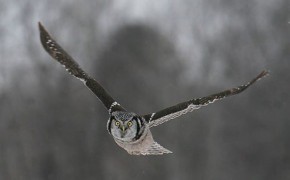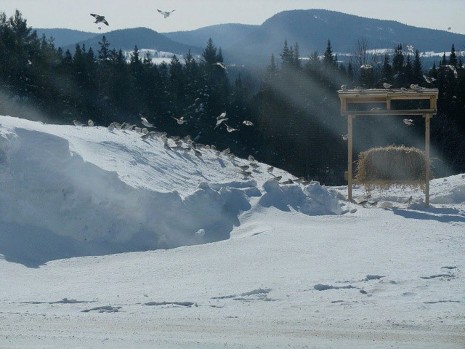Martha Steele

Northern Hawk Owl. All photographs by Bob Stymeist.
Although winter birding generally does not engender the excitement of spring and early summer in New England, it can most certainly produce experiences that remain etched in our memories for life. Such memories for me are not solely about the birds, but also include details on everything about the circumstances of the encounter, including with whom and how we might share those experiences.
Three of my winter birding experiences particularly stick out as extraordinary. In February 2010, Bob and I were lucky enough to enjoy, all to ourselves, a Northern Hawk Owl in North Derby, Vermont, only a football field or two away from the Canadian border. It was a clear, cold, and calm day on a quiet street that ended at the Eagle Point Wildlife Management Area. This is generally open country, managed for grassland and open country birds. Upon arriving, we quickly found the bird perched in the open on a bare tree and facing us. Over the next two hours, we watched the bird’s activities as it flew from tree to bush to telephone wire and back to tree, occasionally dropping down to the snow-covered fields. At that time, my vision was better and I found the bird a stunning specimen, with its piercing eyes, black facial features, and heavily barred breast. I could not take my eyes off the bird, so beautiful, so close,
and so perfect in the classic winter landscape. This is my kind of bird: cooperative, often still and facing us, and simply gorgeous. Our experience was made all the more powerful by our personal and private connection with the bird.
Then came the crowning moment, captured by the photograph taken by Bob that accompanies this column. The owl perched on top of a stop sign at the end of the road. We were looking at it from about 10-20 yards away along the same side of the road. The bird took off and headed straight for us, flying low over our heads and letting us feel the whoosh of its flight mere feet above our heads. These are the indescribable moments that make birding such an adventure and sometimes exhilarating experience. Following the morning in North Derby with the owl, we could have flown ourselves
back home, so excited and thrilled we were.

Snow Buntings at feeding station.
In February 2005, we enjoyed another beautiful winter day while driving from our Vermont home to Montreal, Quebec, to see a spectacular display of winter owls, most notably Great Gray Owls. Reports of large numbers of Great Gray Owls enticed Bob and me, along with Jeremiah Trimble, to head to Montreal to see the spectacle, centered in the L’Île-Bizard–Sainte-Geneviève borough of Montreal and nearby Saint-Eustache. It seemed that every 100–200 yards or so, there would be another Great Gray Owl perched and easily visible near the road. Unlike the Northern Hawk Owl in North Derby, we were not alone in enjoying the scene, as the area was flooded with birders and nonbirders alike. In all, we saw 16 Great Gray Owls that day. But that was not the only species of owl we recorded. We also saw Northern Hawk Owl, Boreal Owl, Great Horned Owl, and several Snowy Owls, along with 260 Bohemian Waxwings; we constantly walked away from whatever bird we were looking at that day, so cooperative were they.
Turning from the more rare winter visitors, I also have many strong images of swirling flocks of Snow Buntings. I most particularly visualize another clear and crisp winter day near our home in Vermont, when we watched a flock of 200-plus Snow Buntings enjoying corn meal at a feeding station by an isolated country road. Below the feeding station, an expansive snow-covered field sloped gently downhill, with a few bare trees in the field. Looking out to the vista, we could see the striking glacially-formed cliffs of Mount Pisgah and Mount Hor framing the frozen Lake Willoughby. I was completely mesmerized by the swooping and swirling and smooth flight of the Snow Bunting flock, periodically truncated by the frenzied feeding on the corn meal. Their abbreviated landings in one of the bare trees in the field, made it appear laden with Christmas tree ornaments. In this case, we could enjoy the birds from the warmth of our car parked along the side of the road, with windows cracked to listen.
Maybe these exhilarating moments occur less often in the winter than other times of the year, but they are no less real or profound. Up close and personal encounters with our winter visitors, rare or common, can quicken our pulse and bring joy to the season. In the midst of these encounters with extraordinary birds, I really do feel like I am living in the moment, thinking of nothing else, worrying about nothing else, and just truly enjoying and feeling the good of that specific moment. It is yet another reason that birding is so special in the surprises that it holds and the opportunity that it offers to truly live in the moment.
Martha Steele, a former editor of Bird Observer, has been progressively losing vision due to retinitis pigmentosa and is legally blind. Thanks to a cochlear implant, she is now learning to identify birds from their songs and calls. Martha lives with her husband, Bob Stymeist, in Arlington. Martha can be reached at marthajs@verizon.net.